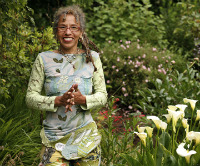 Like the quilters from Gee’s Bend, Marita Dingus uses what she has, in her case, rags, pop tops, pull tabs, computer innards, film negatives,
Like the quilters from Gee’s Bend, Marita Dingus uses what she has, in her case, rags, pop tops, pull tabs, computer innards, film negatives,
bottles, shells, stones, eye glass lenses, yarn, telephone wire, crime
scene tape, drains, battered baking tins, light-bulb sockets, paper clips, plastic flowers, paint brushes, bits of wire, bent silverware, pacifiers, colored tape, paint and coarse thread.
And glass. Her glass heads (thick, flat and transparent) and bodies (pearish) were created in the hot shop at the Museum of Glass under her direction. Her work has a burrowing mole feeling, as if she’s digging
ever deeper into the earth. Glass gives her burrowing intensity a point
of light, a contrast that functions as an intensifier.
She paints features on them and embeds in each aspects of a different
personality.
Currently at the Francine Seders Gallery are a series of her baskets and babies, both haunted by the idea of family.
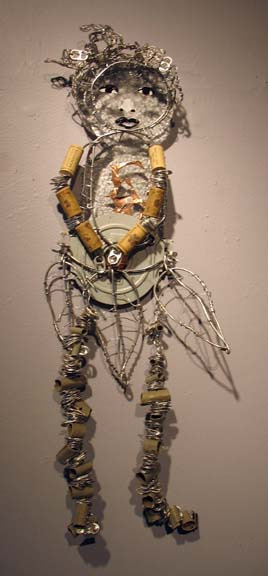
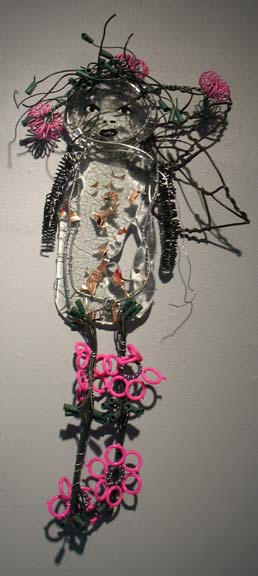 Another family-obsessed Seattle artist, Richard Hugo, took Theodore Roethke‘s poetry class at the University of Washington in the late 1940s and puzzled over a final exam question, “What should the modern poet do about his ancestors?”
Another family-obsessed Seattle artist, Richard Hugo, took Theodore Roethke‘s poetry class at the University of Washington in the late 1940s and puzzled over a final exam question, “What should the modern poet do about his ancestors?”
According to Straw for the Fire: Notebooks of Theodore Roethke, 1943-63, (edited by David Wagoner, 1972), Hugo raised his hand. “Do you mean his blood ancestors or the poets who preceded him?”
Roethke gave nothing away. “Just answer the question,” he said.
Hugo, like Dingus, turned the answer into a life’s work.
For Dingus, the ancestral pull is the African diaspora, the trauma of slavery and its cultural reverberations. From her mother and grandmother, she learned to use a sewing machine as someone else might use a pencil, to articulate form and inflect it with personality. Her baskets are a kind of quilt you can hold in your arms.They evoke the rough grace of a garden with its dirt and worms and catch the visual pulse of an erratic pattern.
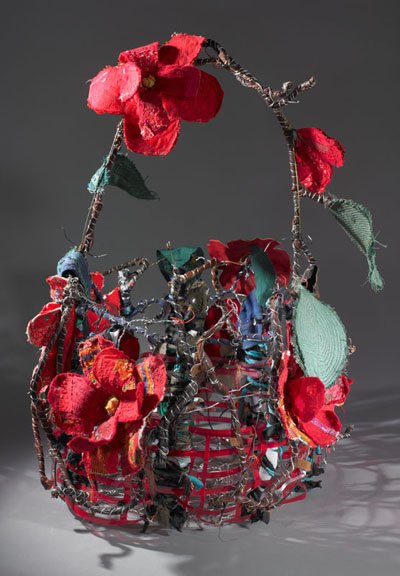 Ragged grace is her signature. What she can pick up for free she cuts, sews, paints and tapes into her sculptures.
Ragged grace is her signature. What she can pick up for free she cuts, sews, paints and tapes into her sculptures.
In everything she does, there is always the wound and the struggle to survive it. What Roethke wrote about cut flowers applies to her work:
This urge, wrestle, resurrection of dry sticks,
Cut stems struggling to put down feet,
What saint strained so much,
Rose on such lopped limbs to new life?
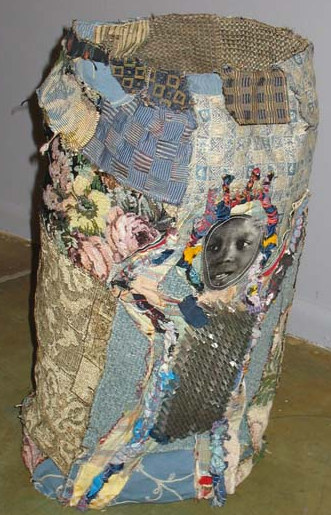 Through Sept. 5.
Through Sept. 5.



What I liked about Ms Dingus’ work in the current show is that her pieces are wired and/or sewn together. These techniques give the work a much better chance of holding up over time.The metal pieces of light bulbs that were wired together is inspired.